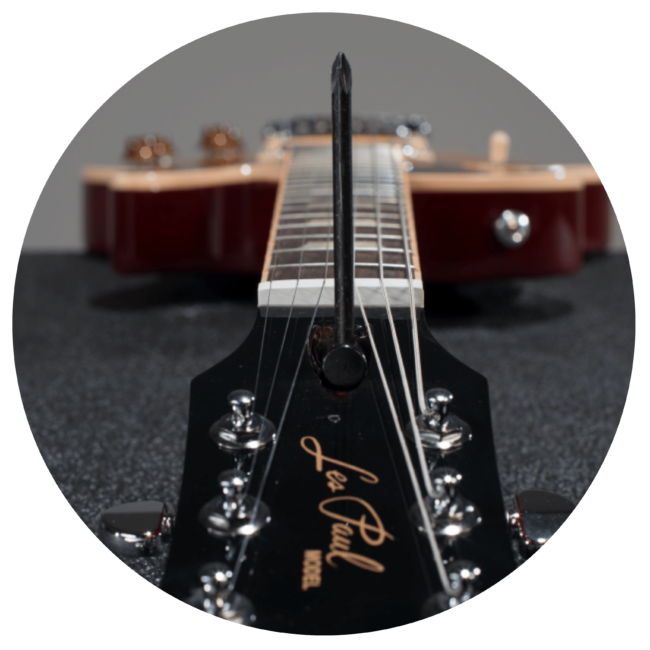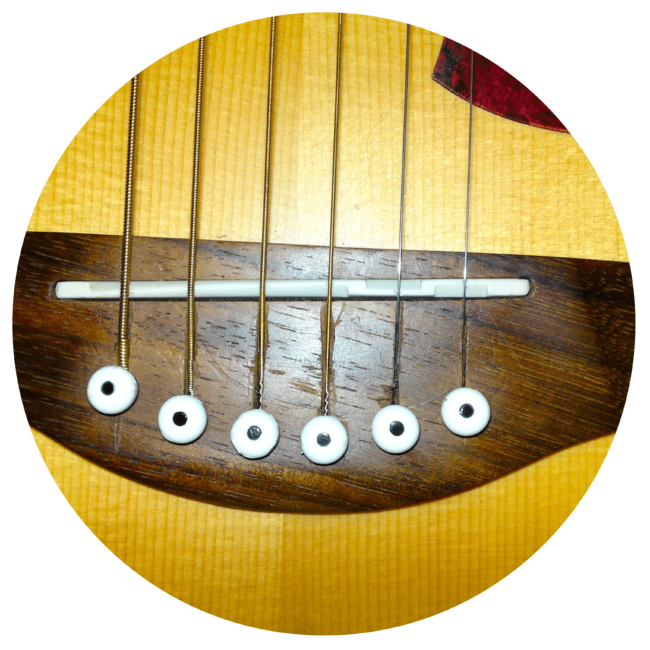Guitar Intonation: How To Intonate A Guitar

What is guitar intonation? How to check guitar intonation? You will find out all the answers in this article.
The guitar is a beautiful-sounding instrument–when it is in tune.
However, sometimes you may notice that some areas of your fretboard are perfectly in tune while other notes sound sharp or flat.
It may mean that your intonation is off.
Let’s look at how to get the perfect intonation for your guitar.
What is guitar intonation? (And why is it important?)
The intonation on a guitar (or any instrument, for that matter) is synonymous with pitch accuracy.
It may sound much like tuning. However, intonation and tuning differ slightly.
Your guitar can be in-tune according to your tuner, but the pitch can still sound off.
Bad pitch can be a guitarist’s worst nightmare–especially if you play in a band.
You may need an intonation adjustment if the notes are sharp or flat even after you tune the guitar strings.
Fixing intonation can be as simple as adjusting how you finger your guitar. Or, you may need to intonate your guitar by adjusting the action, strings, or saddle.
A guitar with perfect intonation allows your chords to sound in tune wherever you choose to play them on the fretboard.
How to check guitar intonation.
A guitar may be in tune and still have poor intonation when you sit down.
You may notice that part of your fretboard sounds in tune, and other areas of your fretboard sound sharp or flat.
Here’s how to check your guitar’s intonation:
First, play an open string and check the note for pitch accuracy on a tuner.
Let the open-string ring while you play the same note on the 12th fret. If you have good intonation, the pitches should sound the same.
To double-check the intonation, you can also test a harmonic. Play an open string, and then play a harmonic at the 12th fret.
You want to check the intonation of each string at the 12th fret. Why the 12th fret, you ask? The 12th fret is generally at the halfway point of the fretboard. It’s at an even distance between the nut and the guitar bridge.
A few of the strings on a guitar may have poor intonation, while others may not need any adjustments. This is especially true for classical guitars with nylon and metal strings on one guitar.
If the fretted or harmonic note is several cents sharp or flat, you may need to adjust your guitar’s intonation.
What can cause guitar intonation problems?
When you play an instrument, you want it to be in tune.
So, when one or more strings have poor intonation, this can be frustrating. It would be best to sit down with a guitar tuner and painstakingly adjust your guitar.
However, there are a few ways to prevent intonation problems in the future. Here are a few ways to keep your guitar in tune all across the guitar:
The guitar action is too high or too low
Many guitarists raise or lower a guitar’s action to play a particular technique. For example, if you play slide guitar, you may want a higher action than usual. A raised action helps your guitar slide slip easily over the fretboard. However, a guitar action that is very high or too low can throw off your intonation.
The usual height for an acoustic guitar is 2.6 mm at the 12th fret. For an electric guitar, the action height should be 1.8 mm at the 12th fret. If the action is okay, check each saddle bridge string.
Humidity levels and weather changes
Changes in the weather and humidity levels can affect more than just your mood. Humidity can dampen the way your guitar sounds. You may need to use a dehumidifier if your area has high humidity levels.
Or, if you are in an area with dry heat, you may need to use a humidifier to protect the soundboard and strings.
Check Choosing the Best Guitar Humidifier to see if you need a humidifier for your guitar.
Worn or rusty strings
The guitar strings can also cause poor intonation on the guitar. The general rule is that you should replace your guitar strings every three months. (Professional guitarists may need to change their strings as often as once a week.) You may also see signs of wear, rust, or corrosion on the strings that tell you it is time.
Changing strings can be a daunting task for beginners. Here is a step-by-step guide to How to Restring a Guitar. Also, many guitar stores restring your guitar for you for a small fee.
The thickness of your strings can also change the intonation of a guitar. Keeping the same string gauge is good if you change the strings.
Your fingering on the frets
When guitarists put more pressure on a fret, it can make the string go sharp.
However, if your touch is too light, notes can sound flat, or you may hear fret buzz. Before changing your guitar’s intonation, adjust how you fret the strings.
So, how do you fix intonation once you discover a problem?
Tips for adjusting guitar intonation.
Adjusting the intonation on your guitar can be a task. You want to do the job right the first time around.
Here are a few tips to make your job easier and save you time:
Give your guitar time to settle
Don’t intonate your guitar immediately after replacing strings, adjusting the truss rod, or changing the action height. Your guitar usually needs two to four days to settle before you make new adjustments. After the fourth day, try the intonation test at the 12th fret to see if your guitar has the proper intonation.
Invest in a quality tuner
An accurate tuner can make your job much easier when you intonate a guitar. It can tell you how much you need to adjust your guitar to get the proper pitch. When you know exactly how many cents your guitar is off, you know how much pressure you need to use to get it back in line.
Check How to Use a Guitar Tuner to find out how to use your tuner effectively.
Protect your guitar as you make adjustments
One slip from a tool as you work on a guitar can leave a permanent mark on your guitar. You can avoid unnecessary scratches and dings on your guitar by using simple precautions as you work.
Protect your guitar by using a microfiber cloth next to screwdrivers, Allen wrenches, or other tools as you work. This gives you a built-in safety net if your finger slips.
Loosen the strings before you work
Before you tighten the bridge saddle or the truss rod, it’s a good idea to loosen the guitar strings. This prevents strings from breakage and wear. Also, it makes reaching the truss rod entry point easier when you loosen the strings.
Make small intonation adjustments
A little goes a long way when you adjust your guitar.
Make small adjustments and check the intonation with a tuner as your work.
Once you finish an adjustment, retune your guitar.
Also, make one change to your guitar in one sitting. For example, if you adjust the truss rod, allow this change to settle for a few days.
If the guitar doesn’t pass the intonation test in four days, try another adjustment, such as moving the bridge.
If it ain’t broke…
You don’t need to intonate your guitar if a simple tuning can do the trick. Before adjusting the bridge saddle or truss rods, check the easy “fixes” first.
Ensure your guitar is in tune, your strings are in good condition, and you use the proper fingering techniques.
If your guitar fails the intonation test, you should buckle down and adjust your guitar’s intonation.
How to intonate a guitar.
If it’s not an issue with the strings, the weather, or your fingering technique, it’s most likely a problem with the bridge saddle. Once you determine that you need to adjust the guitar’s intonation at the saddle, find a reliable tuner and get to work.

Adjust the truss rod
The bow of the neck can affect the intonation of your guitar.
If the truss rod is too tight, the guitar neck begins to bend.
Most guitars with steel strings have a truss rod to support the guitar neck. If your intonation is off, you can try adjusting this guitar piece.
To adjust the truss rod, see if your guitar neck needs a tighter or looser adjustment.
You can do this by laying your guitar on a flat surface. Is the guitar neck bending away from the strings, toward the strings, or straight?
This lets you know if you should loosen the strings, tighten them, or leave them alone.
If you need to adjust the truss rod, look for the point of entry. Usually, there is a hole or cover near the guitar’s headstock.
Tighten the rod by turning it to the right or loosening it to the left.
Once you adjust the neck to the proper position, tune the strings and wait for it to settle.
In two to four days, you can check your guitar’s intonation.

Adjust the bridge saddle
The most common way to intonate your guitar is to adjust the bridge saddle.
Moving the bridge can raise or lower your guitar’s intonation. To know which way to move the bridge, compare a fretted note on the 12th fret with its corresponding harmonic. A tuner can let you know if it is sharp or flat.
If the guitar’s intonation is sharp, move the guitar saddle away from the fretboard. This increases the string length and lowers the pitch.
If the intonation is flat, move the guitar saddle closer to the fretboard. This tightens the strings and raises the pitch.
Now you know the direction to move the bridge… but how?
Adjusting different types of electric guitar bridge saddles
For electric guitars, adjusting the saddle is relatively simple. However, there are many different styles of bridges and saddles you may run into on electric guitars.
Some guitars may tighten by turning to the right. However, others tighten by turning the screwdriver the opposite way. As you make adjustments, go slowly and check the string with a tuner to see if you are going in the proper direction.
Six adjustable saddles: Often, electric guitars have saddles you can adjust separately for each string. These include brands like Fender, Gibson, and others. Adjusting each of the six strings’ saddles, you can get close to perfection.
Most of these saddles use screws which are fairly simple to adjust. However, other guitars like Floyd Rose use hex nuts instead of screws. Adjusting six hex nuts can be more complicated because you must loosen the strings to reach the nut.
Hex nut saddles require more time and patience. However, you still get a precise result at the end of your labor.
One saddle bridge: Some bridges don’t have separate saddles. Instead, all the strings share one saddle. This gives you less control. However, you can still move the bridge for better intonation. These bridges usually come with two adjustment screws at each end of the bridge. You can move both screws if all the strings need adjustment. Or, you can angle the saddle by adjusting only one side. (Most often, the low strings are slightly longer than the treble strings for proper intonation.)
Acoustic Guitars
The saddle can be slightly more difficult to adjust (and less precise) if you have an acoustic guitar. These guitars usually have one saddle spanning the bridge. You can replace the bridge if you notice wear or file down a saddle that is too high.
You can also use a compensated saddle with different height levels for the high and low strings. This offers different levels of tension to intonate your guitar.
Make sure your guitar saddle is at a slight angle. This allows the low-sounding strings to be longer than the treble strings for the best intonation.
Can you ever really get perfect guitar intonation?
You may notice that however often you adjust your guitar, the intonation is never quite “perfect.” Don’t sweat it. You can get very, very close to perfect intonation with proper adjustments to your guitar. However, with fretted instruments, you always have tone variations on the fretboard.
If this imperfection bothers your perfect pitch, you can always try a fretless guitar. But be warned–with a fretless guitar, the intonation relies more on your fingering than the instrument. Want to try it? Check out What is a Fretless Guitar and How to Play It.
Final words.
To play expertly, you want a guitar in tune anywhere on the fretboard. Adjusting your guitar’s intonation can give you an instrument that is satisfying to play. With proper intonation, you can sound like a pro.
Got a great-sounding guitar and want the skills to match? Try out the Simply Guitar app. This app lets you learn the guitar step-by-step and gives you real-time feedback. It’s flexible, fun, and, for the first two weeks, it’s free! Follow the link to start your free trial. See if Simply Guitar is for you!









